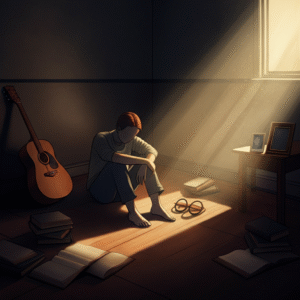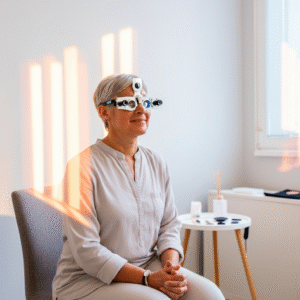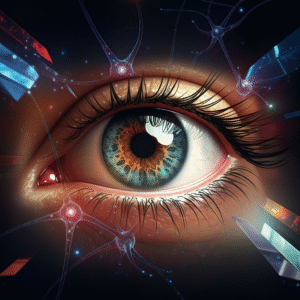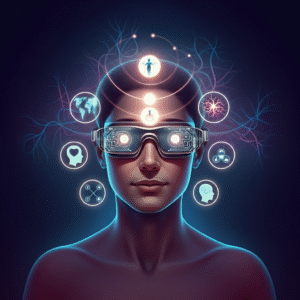Life should be exciting and enjoyable, yet millions of people suffer from anhedonia, the inability to feel joy in the things that they previously enjoyed. It could be due to depression or anxiety, or any other mental health problems. Anhedonia is a condition that can make the most basic pleasures feel unattainable and out of reach. Some innovative solutions are being developed that provide new hope. Of these revolutionary methods, the prism therapy stands out as an original game-like approach that’s changing the way we tackle this challenging problem.
Understanding Anhedonia: When Joy Disappears
Anhedonia is the cause of about 70% of those suffering from depression, and it can have a significant impact on the quality of life. In contrast to stress or sadness that is temporary, it causes a permanent feeling of being disconnected from joy and enthusiasm. Activities that once brought satisfaction, whether it’s listening to music, spending time with loved ones, or pursuing hobbies, suddenly feel empty and meaningless.

Furthermore, conventional talk therapy, although beneficial, can be effective, but it is not always able to tackle the neurologic components that cause anhedonia. This is exactly where the prism therapy approach comes into the picture, providing an entirely new perspective on treatments that transform the way we perceive things around us.
What Is Prism Therapy?
Prism therapy is a novel treatment for a variety of mental and neurological disorders that include anhedonia. In essence, this treatment employs specially-designed prism glasses which alter visual vision by shifting pictures towards one direction. Although it may sound easy however the effects it has on the brain are complicated and beneficial.

The treatment is based on what scientists call “controlled visual displacement.” When a patient wears lenses made of prisms, the vision field shifts, which forces the brain to adjust and develop different neural pathways. This neuroplasticity, the brain’s ability for self-organization, becomes an effective tool to treat ailments such as anhedonia.
The Game-Like Nature of Prism Therapy
What makes the prism therapy approach particularly attractive is its gaming-like character. In contrast to traditional therapy sessions, which can be a bit solitary or overwhelming, it transforms therapy into a stimulating, almost enjoyable experience. Patients take part in a variety of tasks and exercises wearing specialized glasses, resulting in a feeling of achievement and discovery.
In addition, the treatment usually contains elements that are similar to the games and puzzles that are played on video. Patients may engage in visual tracking exercises or spatial reasoning exercises, or even coordination tests. These types of activities are not just less daunting than traditional therapies, but they also activate the brain’s reward system, which is exactly the kind of therapy that people with anhedonia require the most.
How Prism Therapy Addresses Anhedonia
The link between the processing of visual information and emotional well-being goes deeper than many people are aware of. Research suggests that specific brain regions involved in visual processing play important parts in reward processing as well as emotional control. Thus, when prism therapy stimulates these regions, it may help to restore the brain’s ability to feel happiness and a sense of motivation.

In addition, the treatment appears to increase neuroplasticity in the regions connected with dopamine production. Dopamine is often referred to as “the reward chemical”, is commonly depleted by people with anhedonia. Through stimulating the development of new neural pathways, the prism therapy can help to bring back healthy dopamine pathways, gradually building up the capacity for happiness and joy.
The process of visual adaptation also requires focus and commitment, and engagement, which can help patients get from the state of withdrawal commonly caused by anhedonia. When patients face different visual difficulties and challenges, they are rewarded with small wins and successes that slowly build their confidence and self-confidence.
The Science Behind Visual Rehabilitation
Recent studies have shown remarkable results from prism therapy in a variety of circumstances. Research published in top neuroscience journals has demonstrated substantial improvement in motivation, mood, as well as general quality of life for patients. The treatment seems to work by stimulating the brain’s healing mechanisms by controlling visual stimulation.

In addition, the treatment does not require patients to talk about the trauma or engage in emotionally challenging conversations immediately. Instead, it operates at an underlying neurological level, which could make other approaches to therapy more effective after the reward systems in the brain start functioning in a more normal way.
What to Expect During Treatment
Prism therapy sessions usually last 30 to 60 minutes, and are often scheduled throughout the week. Initially, patients may be a bit disoriented while their eyes adjust to prism lenses. But the sensation typically diminishes rapidly when the brain adapts to changes in visual information.
In sessions, therapists who are trained assist patients in various exercises that are designed to maximize therapeutic benefits. This could include exercises in reading, such as object tracking, spatial navigation, or computer-based games. The exact activities differ according to the needs of each patient and the treatment objectives.
The majority of patients notice subtle improvement within the first couple of months of their treatment. This could be a result of increased enthusiasm for previously enjoyable activities and a greater motivation to complete everyday tasks, or a gradual return to positive feelings in social interactions.
Integrating Prism Therapy into Other Therapies
Although prism therapy has shown remarkable potential as a treatment on its own, it is most effective when paired with other therapies. A lot of practitioners combine it with mindfulness, cognitive-behavioral therapy, or medication management to provide complete treatment.

The appeal of this combination is in the way that prism therapy helps improve the effectiveness and effectiveness of the other therapies. As the brain’s reward system starts to function more normally, patients typically find traditional therapy stimulating and effective. Similarly, antidepressant medications may work more effectively when combined with neuroplasticity-enhancing treatments like prism therapy.
Hope for Recovery
Anhedonia isn’t necessarily an ongoing condition. With the advent of cutting-edge treatments like prism therapy, people who are unable to feel pleasure now have many new reasons to be hopeful. The game-like nature of the treatment is accessible and engaging while also addressing the neurological elements of anhedonia.
While research continues to confirm the effectiveness of these therapies, prism therapy can be seen as an important step forward in mental health care. Through harnessing the brain’s natural ability to heal and adapt, it offers an opportunity to return to joy, happiness, and an active engagement with the world. If you suffer from anhedonia, having a look at the prism therapy of a trained expert could be the way to regain the pleasures of life.



